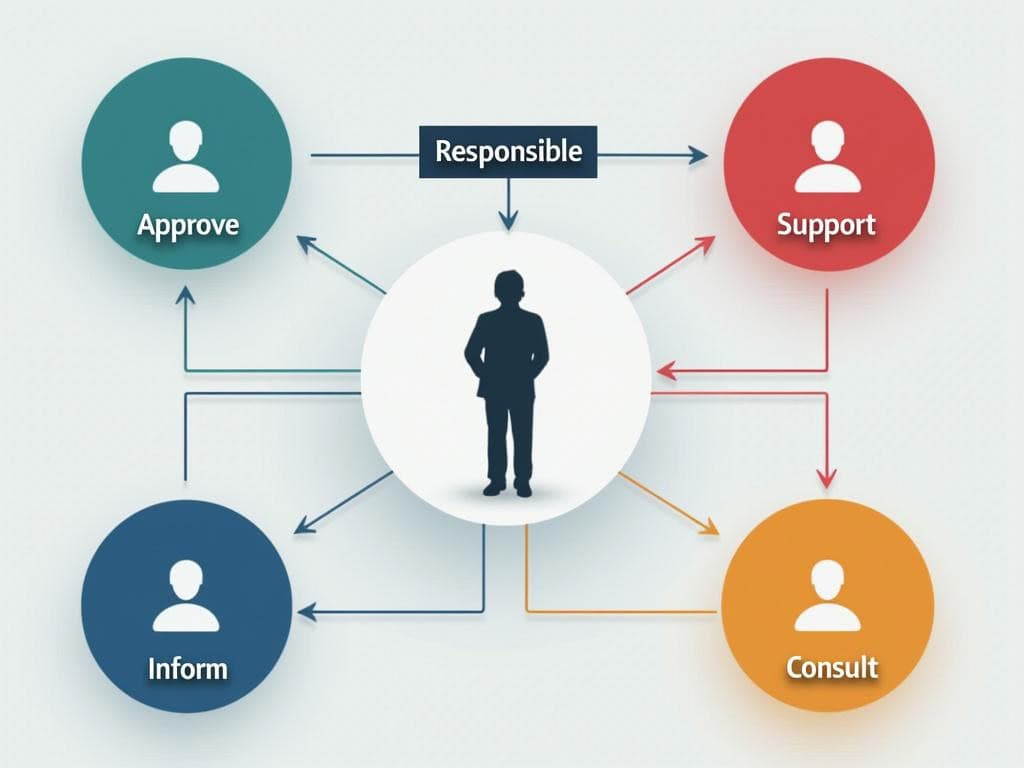
The RASIC Definition in Project Management
The RASIC definition serves as a detailed responsibility assignment matrix that clarifies roles in project management. This framework helps teams understand their specific duties during project execution. By defining five distinct roles – Responsible, Approve, Support, Inform, and Consult – RASIC reduces confusion and improves workflow through clear responsibility allocation.
Key Takeaways
- RASIC provides a structured approach to defining roles and responsibilities in project management.
- The framework includes five specific roles: Responsible, Approve, Support, Inform, and Consult.
- Only one person is typically assigned as “Responsible” for each task to ensure direct accountability.
- RASIC helps reduce miscommunication and project delays by clarifying team member expectations.
- The matrix can be applied across various industries and project types to enhance collaboration and efficiency.
The responsibility assignment matrix creates immediate clarity about who handles what on your project. This approach prevents the common scenario where tasks fall through the cracks because team members assumed someone else was handling them.
Roles in the RASIC Framework
Each role in the RASIC framework has specific functions:
- The Responsible person directly completes the task.
- Someone in the Approve position must sign off on completed work before it moves forward.
- Support roles provide resources or assistance to the Responsible person.
- The Inform designation identifies who needs updates about progress.
- Consult includes subject matter experts who offer guidance.
You’ll find this matrix particularly useful for agile project management where roles often overlap. By implementing RASIC early in your project planning phase, you can prevent bottlenecks and ensure smooth task transitions.
Customization of the RASIC Framework
Many organizations customize the framework to match their specific needs. Some add additional categories while others simplify it. The essential benefit remains consistent: clear accountability that propels projects forward with minimal confusion.
“RASIC is the ultimate roadmap for project clarity, transforming chaos into collaboration by assigning precise roles and responsibilities. With its structured framework of five distinct roles, it empowers teams to navigate tasks seamlessly, ensuring accountability and reducing miscommunication.”
What is RASIC? Understanding the Project Management Tool
The RASIC definition centers on a comprehensive responsibility assignment matrix that helps clarify roles within project management frameworks. This powerful project management tool has evolved from the traditional RACI matrix to provide more detailed role clarity for teams. RASIC stands for Responsible, Approve, Support, Inform, and Consult – five distinct roles that eliminate confusion about who does what during project execution.
You’ll find the RASIC definition particularly useful when managing complex initiatives requiring cross-functional collaboration. The framework assigns clear responsibilities to team members, reducing overlap and ensuring accountability throughout the project lifecycle.
The Five Roles in RASIC Explained
Understanding each component of the RASIC definition helps you implement this tool effectively:
- Responsible: The person who completes the actual task. Only one individual typically receives this assignment to ensure direct accountability and task ownership.
- Approve: The stakeholder authorized to validate or reject completed work, ensuring quality and alignment with requirements.
- Support: Team members providing resources or active assistance to the responsible person, offering expertise or operational backing.
- Inform: Stakeholders who need regular progress updates but aren’t directly involved in task execution.
- Consult: Subject matter experts providing specialized input or technical guidance when needed.
The RASIC definition clarity brings numerous benefits to your projects. By implementing this matrix, you’ll eliminate role confusion while providing visual mapping of responsibilities. This enhances project communication and accountability, reducing delays caused by uncertainty about who handles specific tasks.
When creating an effective RASIC chart, start with comprehensive task identification, then assign appropriate roles for each project element. Ensure each task has one responsible person and communicate the chart transparently. You should regularly update the matrix as your project constraints evolve.
The RASIC definition proves especially valuable in matrix organizations handling complex initiatives. Many technology companies apply this approach during product launches, while healthcare organizations have successfully deployed RASIC during high-pressure scenarios like pandemic response planning.
To maximize project success with RASIC, integrate it into your broader project delivery frameworks and customize the approach based on your specific organizational requirements. This structured approach helps prevent common project management mistakes related to unclear responsibilities.
Clear role definition can increase project success rates by up to 35%.
forbes.com
The Five Roles in RASIC Explained
The RASIC definition refers to a comprehensive responsibility assignment matrix used in project management to establish clear role boundaries. This evolved version of the traditional RACI matrix provides more detailed role clarity by using five distinct designations: Responsible, Approve, Support, Inform, and Consult. Understanding these roles helps eliminate confusion and improves project collaboration across teams.
Breaking Down Each RASIC Component
Each letter in the RASIC definition represents a specific role with clear responsibilities:
- Responsible: The individual who completes the task and delivers results. You’ll typically assign only one person to this role to ensure direct accountability. This person leads task execution and is the primary owner of the deliverable.
- Approve: The authority figure who validates or rejects completed work. This might be a senior stakeholder or technical expert who ensures quality control. Their RASIC definition includes maintaining standards and confirming the correctness of deliverables before final acceptance.
- Support: Team members who provide resources or active assistance. While secondary to the responsible party, their RASIC definition is critical for task facilitation. You’ll rely on them for additional expertise or operational backing throughout the project lifecycle.
- Inform: Stakeholders who need regular progress updates. These individuals don’t actively participate but must stay aware of decisions and project status. Their inclusion helps maintain broader organizational communication and stakeholder satisfaction.
- Consult: Subject matter experts providing specialized input. Their RASIC definition involves offering technical guidance or specialized advice at critical project junctures. You’ll engage them for both one-time reviews and ongoing consultative support.
The RASIC definition provides structure that eliminates role confusion and task overlap in complex projects. By creating a visual mapping of responsibilities, you’ll enhance communication and accountability while reducing delays. This framework is particularly effective in cross-functional projects and applicable across various industries from technology to healthcare.
When implementing RASIC, start by identifying all tasks and stakeholders comprehensively. Assign roles clearly for each project element, ensuring only one person is accountable per task. Communication is key – share the chart transparently with your team and update it regularly as the project evolves. Using this project management framework will help you streamline decision-making and maximize success in complex organizational environments.
Expert Insight: To effectively implement the RASIC framework in project management, begin by clearly identifying all tasks and stakeholders involved. Assign distinct roles—Responsible, Approve, Support, Inform, and Consult—for each task, ensuring that accountability lies with only one individual to minimize confusion. Maintain open communication by transparently sharing and regularly updating the RASIC chart with your team, fostering collaboration and enhancing project outcomes.
Benefits of Implementing RASIC
Implementing the RASIC definition framework brings numerous advantages to your project management process. This responsibility assignment matrix creates clarity and structure that can transform how your teams operate.
You’ll notice immediate improvements in team dynamics when you implement RASIC. The RASIC definition establishes clear boundaries between roles, eliminating confusion about who handles specific tasks. This prevents the common problem of multiple people working on the same task or critical responsibilities falling through the cracks. By mapping out responsibilities visually, everyone understands their contributions to project success.
Key Advantages of RASIC Implementation
The RASIC definition framework offers these specific benefits to your projects:
- Enhanced accountability across team members
- Streamlined decision-making processes
- Reduced miscommunication and delays
- Improved resource allocation
- Clearer escalation paths for issues
- Better cross-functional collaboration
- Decreased project bottlenecks
- More transparent workload distribution
When you strengthen project communication through RASIC, you’ll experience fewer delays caused by uncertainty about task ownership. This responsibility matrix particularly shines in complex projects where multiple departments must coordinate efforts. The RASIC definition provides the structure needed for smooth handoffs between team members.
RASIC also helps prevent scope creep by clarifying who has approval authority. When implementing this framework, you establish distinct roles for those who can authorize changes, reducing the risk of project cost overruns due to uncontrolled additions.
The following table illustrates how RASIC definition implementation addresses common project challenges:
| Project Challenge | How RASIC Addresses It |
|---|---|
| Unclear responsibilities | Explicitly defines who is Responsible, who Approves, etc. |
| Decision bottlenecks | Identifies specific approvers for each deliverable |
| Resource conflicts | Clarifies Supporting roles and their contributions |
| Communication gaps | Specifies who needs to be Informed about progress |
| Missing expertise | Designates who to Consult for specialized knowledge |
For most organizations, the RASIC definition becomes especially valuable during project implementation phases when coordination becomes more complex. The framework helps your teams navigate transitions between project stages while maintaining accountability.

Creating an Effective RASIC Chart
A RASIC definition provides the foundation for successful project management. This comprehensive responsibility assignment matrix serves as a vital tool that assigns specific roles and accountabilities within your project team. The RASIC definition clarifies that this acronym stands for Responsible, Approve, Support, Inform, and Consult – an evolution of the traditional RACI matrix offering more detailed role clarity.
The five roles in the RASIC definition each serve distinct purposes:
- Responsible: The individual who completes the task, typically limited to one person to ensure direct accountability.
- Approve: The authority who validates or rejects completed work, often a stakeholder or technical expert.
- Support: Team members providing active assistance or resources for task completion.
- Inform: Stakeholders who require updates on progress but aren’t directly involved.
- Consult: Subject matter experts who provide specialized input or guidance.
When creating your project communication structure, a clear RASIC definition helps eliminate confusion and enhances accountability. The RASIC definition establishes transparent expectations for everyone involved in your project.
Steps to Create an Effective RASIC Chart
To build a comprehensive RASIC chart, follow these structured steps to ensure your RASIC definition is properly implemented:
- Identify all project tasks and stakeholders.
- Clearly assign one of the five RASIC definition roles to each person for every task.
- Ensure only one person is accountable per deliverable.
- Distribute the completed chart to all team members.
- Regularly update as the project evolves.
This approach is particularly valuable for project constraints and dependencies management. Your RASIC definition provides the framework for addressing complex interdependencies.
The following table demonstrates how a basic RASIC chart might be structured:
| Task/Deliverable | Team Member 1 | Team Member 2 | Team Member 3 | Stakeholder 1 | Stakeholder 2 |
|---|---|---|---|---|---|
| Requirement Doc | R | C | S | A | I |
| Technical Design | C | R | C | I | A |
| Implementation | S | R | S | I | A |
| Testing | S | S | R | I | A |
By implementing a proper RASIC definition in your projects, you’ll experience reduced delays, improved communication, and greater accountability. This powerful tool adapts well across industries from technology to healthcare, and proves especially valuable for challenges of global virtual projects.
Expert Insight: To create an effective RASIC chart, start by clearly identifying all project tasks and stakeholders, ensuring each task has only one Responsible individual to maintain accountability. Assign the appropriate RASIC roles—Approve, Support, Inform, Consult—to each team member for every task to clarify expectations and responsibilities. Regularly review and update the chart as the project evolves to enhance communication and avoid confusion, ultimately driving project success.
Practical Applications and Implementation
The RASIC definition framework adds significant value across diverse organizational contexts. This responsibility assignment matrix clarifies who does what in your projects, eliminating confusion that often leads to delays and quality issues. The RASIC definition specifies five critical roles that establish clear boundaries and expectations for all team members.
You’ll find RASIC particularly beneficial in complex, cross-functional environments where responsibilities frequently overlap. For instance, IT implementation projects using key project implementation phases become more streamlined when team members understand their specific roles through the RASIC definition.
Industry-Specific Applications
Different sectors leverage the RASIC definition in unique ways:
- Technology: Software development teams use RASIC to clarify ownership across development, testing, and deployment phases.
- Healthcare: Hospital improvement initiatives apply RASIC definition to maintain clear clinical and administrative responsibilities.
- Manufacturing: Production line improvements benefit from RASIC definition by delineating roles across engineering, operations, and quality control.
- Financial services: Compliance projects utilize RASIC definition to ensure regulatory requirements have clear ownership.
The flexibility of this framework makes it particularly valuable when collaborating on complex projects with multiple stakeholders. Organizations experiencing rapid growth find the RASIC definition essential for maintaining clarity as teams expand.
Implementation success depends on thorough documentation and communication. You should create a comprehensive RASIC chart listing all project tasks vertically and stakeholders horizontally. This visual representation of the RASIC definition helps everyone understand their contributions at a glance.
| Task | Project Manager | Developer | QA Analyst | Department Head | End User |
|---|---|---|---|---|---|
| Requirements Gathering | R | S | C | A | I |
| Code Development | I | R | C | A | I |
| Testing | I | S | R | A | C |
| Deployment | R | S | I | A | I |
| Training | S | I | I | A | R |
Regular reviews of your RASIC definition assignments ensure responsibilities remain aligned with project needs. The RASIC definition provides exceptional clarity when managing risk response strategies by explicitly stating who handles each mitigation action.
Ultimately, effective implementation of the RASIC definition framework transforms how your teams collaborate, reducing bottlenecks and accelerating project delivery while maintaining quality standards.
Maximizing Project Success with RASIC
The RASIC definition refers to a comprehensive responsibility assignment matrix that provides detailed clarity in project management. This framework evolved from the traditional RACI matrix to offer more precise role delineation. The RASIC definition encompasses five distinct roles that help teams understand exactly who does what during project execution.
RASIC stands for Responsible, Approve, Support, Inform, and Consult. Each letter in the RASIC definition represents a specific function within your project team structure. When properly implemented, the RASIC definition creates a visual roadmap of accountability that prevents confusion and streamlines workflow.
The Five Essential Roles in the RASIC Definition
Understanding each component of the RASIC definition helps you create better project structures. Here’s what each role entails:
- Responsible: The person who completes the task, typically limited to one individual to ensure direct accountability
- Approve: The authority who validates or rejects completed work, ensuring quality standards are met
- Support: Team members providing resources or active assistance to facilitate task completion
- Inform: Stakeholders who need to receive progress updates but aren’t directly involved in the work
- Consult: Subject matter experts who provide specialized guidance or technical advice
The RASIC definition offers several advantages when managing integrated projects. You’ll experience fewer delays, clearer communication, and improved accountability. The RASIC definition is particularly valuable for complex, cross-functional projects where multiple departments must coordinate effectively.
To create an effective RASIC chart, start by identifying all tasks and stakeholders. Then assign appropriate roles for each project element, ensuring one person is accountable per task. The RASIC definition should be communicated transparently across your team and updated regularly as the project evolves.
The RASIC definition works exceptionally well in matrix organizations and complex environments. When you implement clear communication strategies alongside your RASIC chart, you’ll see improved team coordination and faster decision-making. The RASIC definition helps eliminate confusion about who approves what, who needs information, and who provides specialized input.
For maximum effectiveness, integrate the RASIC definition into your broader project management strategy. The RASIC definition can transform how your teams collaborate, especially when facing tight deadlines or working across departments. By clearly defining the RASIC roles, you’ll reduce conflicts and create more efficient workflows throughout your project lifecycle.






